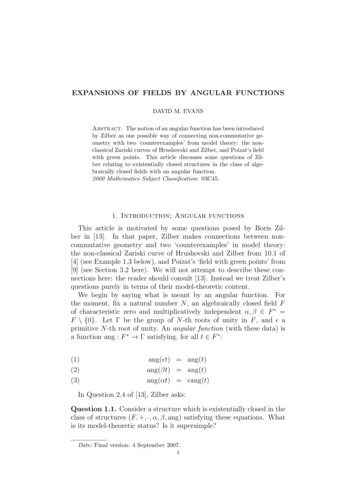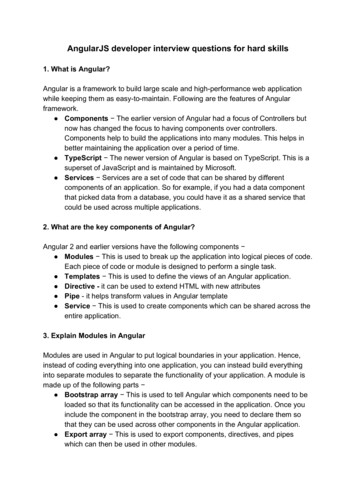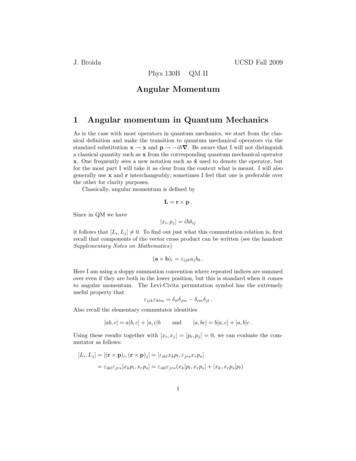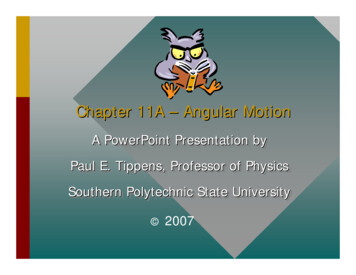
Transcription
EXPANSIONS OF FIELDS BY ANGULAR FUNCTIONSDAVID M. EVANSAbstract. The notion of an angular function has been introducedby Zilber as one possible way of connecting non-commutative geometry with two ‘counterexamples’ from model theory: the nonclassical Zariski curves of Hrushovski and Zilber, and Poizat’s fieldwith green points. This article discusses some questions of Zilber relating to existentially closed structures in the class of algebraically closed fields with an angular function.2000 Mathematics Subject Classification: 03C45.1. Introduction; Angular functionsThis article is motivated by some questions posed by Boris Zilber in [13]. In that paper, Zilber makes connections between noncommutative geometry and two ‘counterexamples’ in model theory:the non-classical Zariski curve of Hrushovski and Zilber from 10.1 of[4] (see Example 1.3 below), and Poizat’s ‘field with green points’ from[9] (see Section 3.2 here). We will not attempt to describe these connections here: the reader should consult [13]. Instead we treat Zilber’squestions purely in terms of their model-theoretic content.We begin by saying what is meant by an angular function. Forthe moment, fix a natural number N , an algebraically closed field Fof characteristic zero and multiplicatively independent α, β F F \ {0}. Let Γ be the group of N -th roots of unity in F , and aprimitive N -th root of unity. An angular function (with these data) isa function ang : F Γ satisfying, for all t F :(1)(2)(3)ang( t) ang(t)ang(βt) ang(t)ang(αt) ang(t)In Question 2.4 of [13], Zilber asks:Question 1.1. Consider a structure which is existentially closed in theclass of structures (F, , ·, α, β, ang) satisfying these equations. Whatis its model-theoretic status? Is it supersimple?Date: Final version: 4 September 2007.1
2DAVID M. EVANSBefore making more precise what our answer to this question is, wegive some definitions and the examples which motivate the terminologyand the question.Note that associated to any angular function ang there are two definable subgroups of the multiplicative group of the field. The groupof periods of ang isG {g F : ang(gt) ang(t) t F };and the group of quasiperiods of ang isG {h F : γ Γ t F ang(ht) γang(t)}.So Γ G G and there is a definable homomorphism χ : G Γwith kernel G (given by ang(ht) χ(h)ang(t) for h G and t F ).Note that as defined above, χ is surjective, so the induced map χ̄ :G /G Γ is an isomorphism.Example 1.2. The following example from 2.3 of [13] provides themotivation for the terminology ‘angular function.’ Let F C, thecomplex numbers and exp(2πi/N ). For k 0, . . . , N 1, let Pk bethe sector of the complex plane consisting of non-zero complex numbersz with an argument argz in the range 2πk/N argz 2π(k 1)/N .We define ang : C Γ by, for t C :ang(t) k tN Pk .The group of periods of ang is G R 0 Γ and the group of quasiperiodsis G R 0 h 1 i where 1 exp(2πi/N 2 ).It is clear that (C, , ·, ang) has the strict order property (consideradditive translates of the definable subset P0 ).Example 1.3. We describe briefly, following Section 1 of [13], how toobtain an example of a non-classical Zariski curve from a suitable angular function. Given (F ; , ·, α, β, ang) satisfying the above equations,(and where hα, βi is free abelian of rank 2) define U, V : F F byU (t) αtV (t) βang(t)t.These are definable permutations of F andV U (t) U V (t).Let T denote the set F with only the structure given by the definablepermutations U, V and p : T F given by p(t) tN . Then the structure ((T ; U, V ), (F ; , ·), p : T F ) is a finite cover of (F ; , ·) whichis interpretable in (F ; , ·, ang), but not in (F ; , ·). More detatils canbe found in Section 1 of [13] and Section 10 of [4].We now return to Question 1.1. The intention is to add a generic angular function, having prescribed in advance the groups of periods and
EXPANSIONS OF FIELDS BY ANGULAR FUNCTIONS3quasiperiods (rather than also having an existential closure conditionon, say, the group of periods). Thus we make the following definitions.Definition 1.4. Let L0 be a first-order language which contains thelanguage of rings ( , , ·, 0, 1) and additional unary predicates F, Γ, Gand G , and a unary function symbol χ. Let F be an algebraicallyclosed field of characteristic 0, and Γ G G F subgroups ofthe multiplicative group of F . Suppose χ : G Γ is a surjectivehomomorphism with kernel G. We consider this as an L0 -structure,where F is interpreted as F , Γ as Γ, G as G, G as G and χ as χ.Let T0 T h(F ; , , ·, 0, 1, Γ, G, G , χ, . . .) be the L0 -theory of thisstructure. Without loss, we shall assume that L0 has been extended sothat T0 is model-complete. Note that if Γ is finite, then G and χ aredefinable (with parameters) from G in the multiplicative group F .Now let LA be the expansion of L0 by an extra unary function symbolA. We define TA to be the theory axiomatized by T0 and axioms:(i) (A(0) 0) ( t)((t 6 0) Γ(A(t)));(ii) ( t)( g)(G(g) A(g · t) A(t));(iii) ( t)( h)(G (h) (t 6 0) A(h · t) χ(h) · A(t))Thus in a model M of TA , the subgroups G(M ) and G (M ) arecontained in the periods and quasiperiods of the angular function AMand it is easy to show that if M is an existentially closed model ofTA , then they are exactly the periods and quasiperiods ( a priori itis not immediately obvious that TA is even consistent, but this willbecome clear from Lemma 2.1). Question 1.1 can then be seen as askingwhether the class of existentially closed models of TA is axiomatizable,and if so whether completions of its theory are supersimple. In Section2 we prove:Theorem 1.5.(1) If T0 eliminates the quantifier in the sortsF, F/G and F/G then TA has a model companion TA .(2) If additionally T0 is simple and Γ is finite then all completionsof TA are simple (and in the same simplicity class as T0 ).By the parenthetic remark at the end of (2), we mean, for example,that if T0 is supersimple of SU -rank κ, then so is any completion ofTA . If Γ is non-trivial, then TA will not be stable.Essentially both parts of the theorem follow quickly from knownresults. As we shall see, the first follows from an old theorem of Winkler[10], and the second follows from results of Nübling in [5]. Of course,for the result to be of any relevance to Zilber’s question we need toidentify suitable T0 which satisfy its hypotheses.We consider two situations where the model theory of an algebraicallyclosed field of characteristic zero expanded by a predicate for a subgroup of the multiplicative group is understood. In the first case, the
4DAVID M. EVANSsubgroup is in the divisible hull of a finitely generated group (– structures of Lang type). In the second case, we consider structures constructed via a Hrushovski predimension as in Poizat’s ‘field with greenpoints’ from [9] (– structures of Poizat type). The first case is relevantto Section 2 in Zilber’s paper [13] and the second case is relevant toSections 3 and 4 there.In both cases we are dealing with superstable structures (of infiniteU -rank). Both cases have weak nfcp, that is, they eliminate in all(real and imaginary) sorts. For structures of Lang type, this is folk-lore;for structures of Poizat type we give a proof using belles paires.In Section 4 we show how to put a probability measure on definablesets in models of TA , giving one possible answer to the problem at theend of Section 2 of [13].2. Winkler’s Theorem and the proof of Theorem 1.5Throughout this section we use the notation of Definition 1.4. Suppose we have a model M of TA . If the model is understood from thecontext, we will abuse notation and write G instead of G(M ) etc.Rather than considering the angular function A : F Γ we considera section s : F /G F /G of the natural map ν : F /G F /G (given by ν(xG) xG ) which is interdefinable with A. More formally,suppose L0 has been expanded to include the part of Leq0 involving the sorts F /G and F /G. Expand L0 further to a language Ls which hasan extra unary function symbol s between these sorts. Let Ts be theLs -theory axiomatized by T0 and the axiom:( y F /G )(s(y)G y)saying that s is a section of the L0 -definable map ν.Lemma 2.1. There is a definable correspondence between the models ofTA and the models of Ts which preserves the property of existential closure. Thus TA has a model companion (respectively, model completion)if and only if Ts does.Proof: The correspondence is given by the equation:A(t) χ̄(s(tG ) 1 tG).Indeed, given a section s of ν, then s(tG ) 1 tG G /G and χ̄ mapsthis into Γ. So A given by this equation is certainly a map from F toΓ and it is easy to check that it satisfies the axioms in Definition 1.4.Conversely given an angular function A, the above equation determinesa function s : F /G F /G given by:s(tG ) tG(χ̄ 1 (A(t))) 1 ,because χ̄ is bijective, and one checks easily that this is a section of ν.The above correspondence is given by a quantifier-free formula, so ittranslates existentially closed structures in one class into existentially
EXPANSIONS OF FIELDS BY ANGULAR FUNCTIONS5closed structures in the other. This proves the statement about theexistence of model companions. For the statement about model completions, observe that TA has the amalgamation property iff Ts has theamalgamation property.2By the above lemma it will suffice to prove Theorem 1.5 for thetheory Ts . The advantage of this is that s only has a simple axiomto satisfy: that of being a section of a certain definable map. This isexactly the situation in which we can apply a result of Winkler fromthe 1970’s. In the following, L is any first-order language and T anyL-theory.Definition 2.2. We say that T eliminates the quantifier ‘there existinfinitely many’ (or eliminates , or is algebraically bounded ) if forall L-formulas φ(x, ȳ) there is a natural number Nφ with the propertythat for all models M of T and ā in M , if φ[M, ā] has more than Nφelements, then it is infinite.Definition 2.3. Suppose φ(x, ȳ) is an L-formula, where ȳ is an n-tupleof variables. Let L be the expansion of L by a new n-ary functionsymbol σ. The L theory T is axiomatized by T together with thenew axiom:( ȳ)(( x)φ(x, ȳ) φ(σ(ȳ), ȳ)). We refer to T as a Skolem expansion of T .So of course this says that σ is a Skolem function for the formulaφ(x, ȳ). Strictly speaking, σ should be defined for all n-tuples, even ifthey do not satisfy ( x)φ(x, ȳ). We can avoid this issue by including asort for the definable set ( x)φ(x, ȳ) and only defining σ on this sort.Alternatively we can define σ(ȳ) to be some fixed -definable element.Theorem 2.4 (P. Winkler, Theorem 2 of [10]). Suppose T is a modelcomplete L-theory which eliminates the quantifier . Then any Skolemexpansion T of T has a model completion (T ) .2Proof of Theorem 1.5: (1) The theory Ts is the Skolem expansion ofT0 with respect to the formula φ(x, y):(x F/G) (y F/G ) (xG y).The assumptions on eliminating in the indicated sorts means thatwe can apply Winkler’s Theorem to deduce that Ts has a model completion Ts . So by Lemma 2.1 there is a model completion TA of TA .(2) If Γ is finite, then Γ is finite in all models of T0 and the map ν is Γ -to-1. So the Skolem expansion Ts is an algebraic Skolem expansion(in the terminology of [5]) and the results in Section 1 of [5] give immediately that if T0 is simple then so is any completion of Ts (and inthe same simplicity class). By interdefinability of TA and Ts , the sameis true of TA .2
6DAVID M. EVANSRemarks 2.5. The result in [10] is more general than is stated inTheorem 2.4: one has a model completion for the expansion by anarbitrary number of Skolem functions. By Theorem 4 of [10] thereis also a converse to Theorem 2.4: if there is a model companion forT then T eliminates . By combining these results, one obtains([10], Corollary 1) that the model completion (T ) in Theorem 2.4eliminates .The proof of Theorem 2.4 gives an axiomatization of Ts . As well asTs we have axioms of the form: x̄(( ȳ)α(x̄, ȳ) ( ȳ)(α(x̄, ȳ) β(x̄, ȳ)))where(i) α is an L0 -formula and β is a conjunction of formulas of theform ‘s(v1 ) v2 ’ where v1 , v2 are amongst the variables in x̄, ȳ,not both in x̄ (and no variable appearing as v1 is in more thanone such conjunct).(ii) If i 6 j then yi 6 yj is a conjunct of α and if ‘s(v1 ) v2 ’ is aconjunct of β, then φ(v2 , v1 ) is a conjunct of α.It should be noted that ‘ ȳ . . .’ here means ‘there exist infinitely manyȳ which are different in each coordinate’ (see the definition in Section1 of [10]).Remarks 2.6. We note that if, in Theorem 1.5 the group Γ is notfinite (and F /G is infinite), then Ts and TA cannot be simple. Theargument is essentially that of Lemma 3.1 of [5]. In fact, the formulaθ(x; y, z) given by A(x · y) z has the tree property (with respect toTs ). In some model of Ts take (ai : i ω) in F lying in differentG -cosets, and distinct elements (gj : j ω) of Γ. For η ω ωwith domain n 0 consider the parameters cη (an , gη(n 1) ). Clearly{θ(x; c(ηˆj )) : j ω} is pairwise inconsistent for each η ω ω , andusing the above axioms for Ts one shows that for ζ ω ω the set{θ(x; cζ n ) : n ω} is consistent.3. Weak nfcpSuppose L is a first-order language and T a complete L-theory. Thenby a theorem of Shelah, T has nfcp (‘does not have the finite coverproperty’) if and only if it is stable and eliminates the quantifier in all (real and imaginary) sorts. The latter property (for arbitrary T )is sometimes referred to as weak nfcp. In this section we discuss twotypes of stable theories T0 to which we would like to apply Theorem1.5, and show that they have weak nfcp.3.1. Structures of Lang type. Recall that an abelian group is saidto be of finite
2 8t2F ang(ht) ang(t)g: So G G and there is a de nable homomorphism : G ! with kernel G(given by ang(ht) (h)ang(t) for h2G and t2F ). Note that as de ned above, is surjective, so the induced map : G G! is an isomorphism. Example 1.2. The following example from 2.3 of [13] provides the motivation for the terminology ‘angular .











